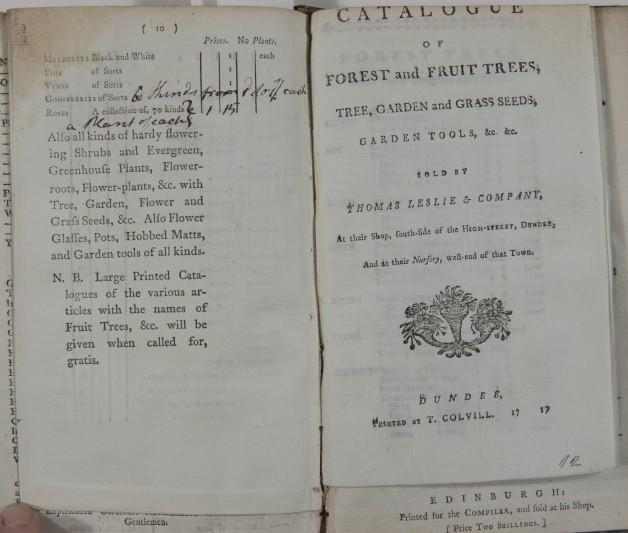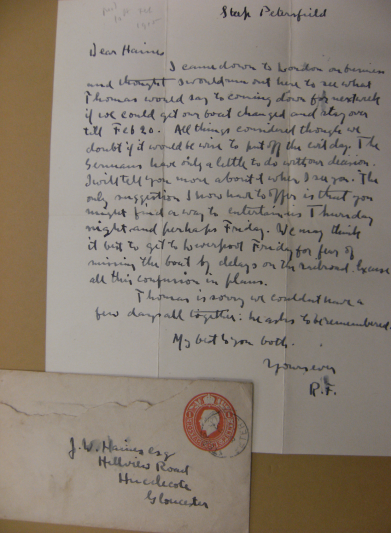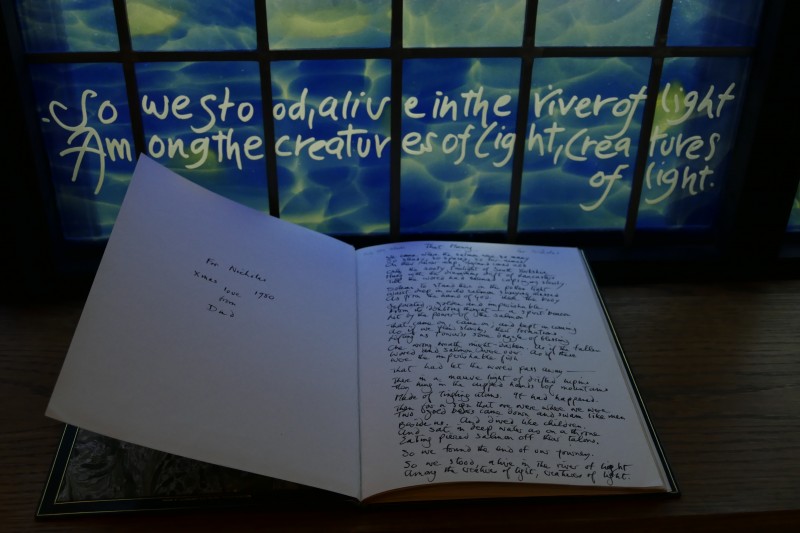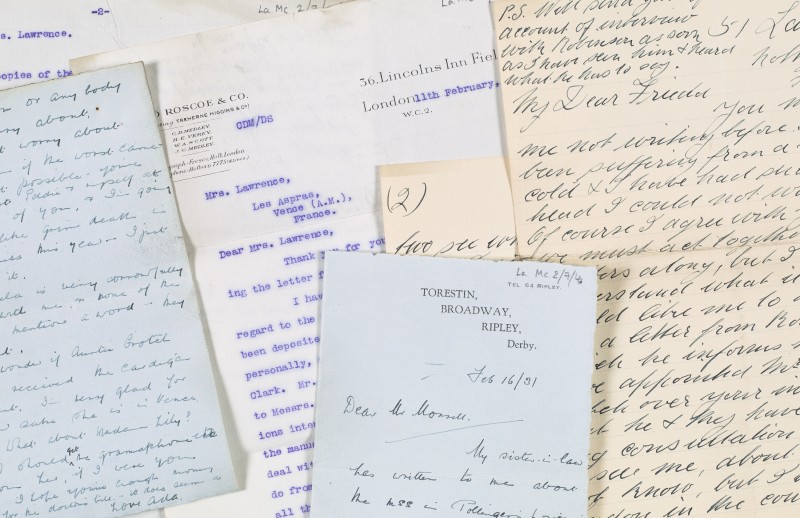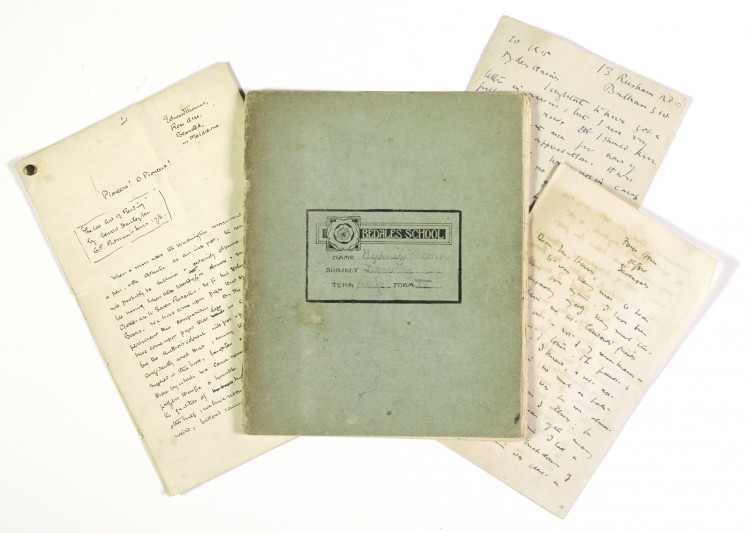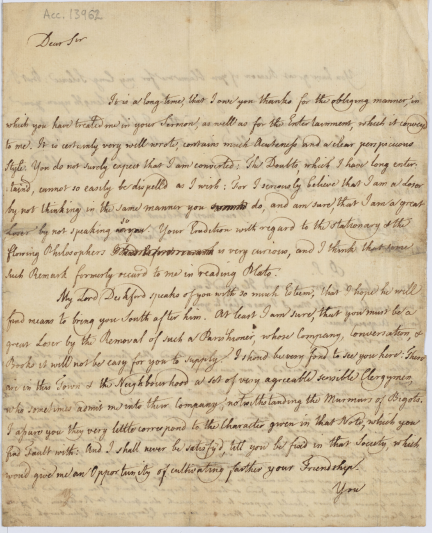Displaying 211 - 220 of 2051
Item date: 1765-1784
Date acquired: 2018
Grant Value: £15,000
Item cost: £25,000
Institution: Royal Botanic Garden, Edinburgh
Town/City: Edinburgh
“Tracts Coal & Nursery” is a collection of papers and 18th century nursery catalogues.
The volume includes a collection of catalogues from plant nurseries in Scotland issued between 1765 and 1784 bound with two pamphlets from 1777 and 1784 on the qualities of coal tar and a copy of the 1765 Act for encouraging the Cultivation, and for the better Preservation of Trees, Roots, Plants, and Shrubs. Of the 16 nursery catalogues in the volume, 12 were not previously available in libraries in either Scotland or the rest of the UK and three were variations on copies in the existing RBGE collection.
Author: Robert Frost
Item date: 8 February 1915
Date acquired: 2018
Grant Value: £1,691
Item cost: £1,691
Institution: Petersfield Museum & Art Gallery [incorporating the Edward Thomas Study Centre]
Town/City: Petersfield
County: Hampshire
Since 2017 an extensive and important collection of over 2,000 books and other items, including some letters, by and about the early 20th-century literary reviewer, writer and poet Edward Thomas, has been held at Petersfield Museum's Edward Thomas Study Centre, on loan from the Edward Thomas Fellowship. The opportunity to add this letter, with its local significance is a significant step forward for the Museum and the Edward Thomas Fellowship as both seek to further establish the Study Centre as an important resource for Thomas scholars and the wider public.
Author: Ted Hughes
Item date: September 1971
Date acquired: 2018
Grant Value: £4,375 [B.H. Breslauer Foundation Fund]
Item cost: £7,500
Institution: Pembroke College Library, Cambridge University
Town/City: Cambridge
County: Cambridgeshire
Hughes signed and dated this copy in September 1971, but retained it until 1980, when it became a Christmas present for his son and fishing companion Nicholas. It is the most intimate testimony to the passions they shared. As well as manuscript copies of its opening two printed poems, ‘An Otter’ and ‘Pike’, both from Lupercal (1960), it contains seven more fishing poems, none yet published.
Item date: 1931
Date acquired: 2018
Grant Value: £2,500
Item cost: £3,500
Institution: University of Nottingham
Town/City: Nottingham
County: Nottinghamshire
This small archive relating to the literary estate of D.H. Lawrence (1885-1930). The acquisition now forms part of our DH Lawrence Collection, which was designated in 2008 by the former Museums, Libraries and Archives Council as being of national and international importance. It adds to our knowledge of the fraught relationship between Frieda and Lawrence’s siblings and the dispute over the rightful ownership of his manuscripts and the payment of royalties.
Author: Thomas Pierce
Item date: London: printed by R.N. for R. Royston, 1670
Date acquired: 2018
Grant Value: £1,517 [B H Breslauer Foundation Fund]
Item cost: £2,250
Institution: National Trust, Gunby Hall
Town/City: Spilsby
County: Lincolnshire
Thomas Pierce The sinner impleaded in his own court. Wherein are represented the great discouragements from sinning, which the sinner receiveth from sin it self.
The National Trust is very grateful to the Friends of the National Libraries for a grant that enabled us to repatriate this volume back to the shelves of Gunby Hall, Lincolnshire. Thomas Pierce’s The sinner impleaded, the first edition of which appeared in 1656, is a key text for outlining Pierce’s objection to Calvinist doctrine and his staunch support of episcopacy. Pierce’s various publications placed him at the centre of the religious controversy of the day but the present work is his most enduring effort, having gone through four editions by 1679.
Author: Jack Haines (1875-1960); Edward Thomas (1878-1917)
Item date: 1903-1922
Date acquired: 2018
Grant Value: £20,000
Item cost: £70,481
Institution: National Library of Wales
Town/City: Aberystwyth
County: Ceredigion
A small, yet important group of literary papers relating to the poet, writer and soldier Edward Thomas (1878-1917). The items acquired were all once in the possession of Thomas’s friend, the Gloucester lawyer and bibliophile Jack Haines (1875-1960). The most significant and interesting item is a school exercise book once used by Myfanwy, Thomas’s daughter, which was reused by him to write his poetry. Although only eight leaves remain in the book, they contain multiple drafts, in his own hand, of two of his very earliest poems, ‘The Mountain Chapel’ and ‘Birds’ Nests’. They are dated 17 and 18 December respectively, only a few weeks after Thomas began writing poetry in earnest.
Author: David Hume (1711-1776)
Item date: 1755
Date acquired: 2018
Grant Value: £4,000
Item cost: £41,600
Institution: National Library of Scotland
Town/City: Edinburgh
The unpublished letter, written in 1755, and the only known correspondence with Traill, concerns Hume’s recent reading of a sermon by Traill where he confronts Hume’s disparaging remarks about the Scottish clergy. Hume had previously criticised them in his 1748 essay ‘Of National Characters’ where he remarked that their need to ‘feign more devotion than they are… possessed of’ led them to ‘promote the spirit of superstition, by a continued grimace and hypocrisy’. Traill responded with his published sermon The Qualifications and Decorum of a Teacher of Christianity Considered (1755).
Author: Attributed to Louis Jules Duboscq (1817-1886).
Item date: 1851
Date acquired: 2018
Grant Value: £10,000
Item cost: £30,000
Institution: London Metropolitan Archives
Town/City: London
The daguerreotype is one of London Metropolitan Archives’ earliest photographs of a City of London scene and the only known stereoscopic daguerreotype of a City of London street scene. London Metropolitan Archives has scarcely a handful of photographs taken before 1860 and none that show the riverfront in the City pre-1860. The photograph is likely to have been taken from the site of Albion Mills, looking across the river towards the City with St Paul’s prominently rising above the warehouses and wharves on the riverside. This particular view is not well represented at this date by known prints and drawings and none approach the level of detail in the Duboscq stereoscopic daguerreotype.
Author: Laurence Sterne (1713-1768)
Item date: New York, 1884
Date acquired: 2018
Grant Value: £495
Item cost: £495
Institution: Laurence Sterne Trust
Town/City: York
County: Yorkshire
In 1768 he published the first two volumes of A Sentimental Journey through France and Italy promising his subscribers that the remaining two volumes would be published ‘early the next Winter’. Sterne died a month later leaving the story incomplete.
The original watercolour drawing by Leloir on the half-title (each one unique to every copy in this limited edition) does not seem to make a direct reference to the narrative of the text and so Leloir seems to be creating new, unique scenes in addition to the illustrations throughout the text.
Item date: Printed in Venice by Nicolaus Jenson, 21 May 1471.
Date acquired: 2018
Grant Value: £20,000 [of which half was from the B H Breslauer Foundation Fund]
Item cost: £50,000
Institution: Lambeth Palace Library
Town/City: London
The only printed book from Morton’s library known to survive in private hands: it is again a Venetian edition of the 1470s, of the Institutiones oratoriae, a textbook on the theory and practice of eloquence by the classical Roman rhetorician, Marcus Fabius Quintilianus. This work, which quickly established itself in humanist educational circles, may also have had practical uses for Morton, who could well have bought it new during one of his diplomatic missions to France, Flanders or Rome in the 1470s and 1480s. Typographically a strikingly beautiful book, it bears Morton’s handsomely painted arms on its first leaf, and below this a rebus, punning on Morton’s name – a barrel, or tun, with the letters MOR. Running through this copy is a system of foliation and subject headings, written in the upper margins in a 15th-century English hand, which seems to be common to several of Morton’s surviving books.
